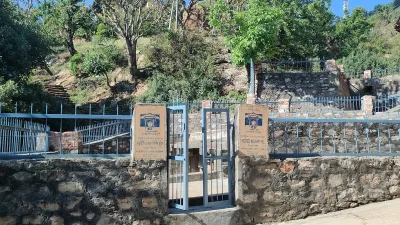The U.S. Conference of Mayors has resolved to phase out purchasing bottled water, not only for environmental reasons, but as a way of encouraging more financial support for municipal water systems.
"It started with San Francisco's Mayor Gavin Newsom, but now the rest of the country is getting on board. Last summer Newsom issued an executive order canceling San Francisco's bottled water contracts. Now, at the U.S. Conference of Mayors, which represents more than 1,100 mayors nationwide, a resolution was passed to encourage all mayors to phase out their cities' spending on bottled water and to promote tap water.
'It's just plain common sense for cities to stop padding the bottled water industry's bottom line at taxpayer expense,' said Gigi Kellett, national director of CAI's Think Outside the Bottle campaign. 'This resolution will send the strong message that opting for tap over bottled water is what's best for our environment, our pocketbooks and our long-term, equitable access to our most essential resource.'
The bottled water industry has grown into an $11.5 billion empire in recent years that went virtually unchallenged until last year, when a massive backlash began, ignited mostly by an increasing environmental awareness about bottled water. For one, Food and Water Watch reported that it takes 17.6 million barrels of oil each year to make all the plastic bottles we need in the United States -- the equivalent of one than 1 million vehicles on the roads -- not to mention all the fuel it takes to ship the bottles to stores and to dispose of them. More than 80 percent of the bottles end up in landfills or tossed onto the street, making their way into our waterways; some even end up in the giant plastic whirlpool circling in the Pacific Ocean that is poisoning marine life and birds.
While tap water may be safer than most bottled water, we need increasing vigilance to protect funding to keep it that way and to ensure continued federal funding for our public water infrastructure. It is estimated that cities need $22 billion each year to keep up their public water systems, and the Conference of Mayors resolution is one way to help increase support for public water."
FULL STORY: Is Your City Going to Be Bottled Water-Free?

Trump Administration Could Effectively End Housing Voucher Program
Federal officials are eyeing major cuts to the Section 8 program that helps millions of low-income households pay rent.

Planetizen Federal Action Tracker
A weekly monitor of how Trump’s orders and actions are impacting planners and planning in America.

Ken Jennings Launches Transit Web Series
The Jeopardy champ wants you to ride public transit.

Washington Legislature Passes Rent Increase Cap
A bill that caps rent increases at 7 percent plus inflation is headed to the governor’s desk.

From Planning to Action: How LA County Is Rethinking Climate Resilience
Chief Sustainability Officer Rita Kampalath outlines the County’s shift from planning to implementation in its climate resilience efforts, emphasizing cross-departmental coordination, updated recovery strategies, and the need for flexible funding.

New Mexico Aging Department Commits to Helping Seniors Age ‘In Place’ and ‘Autonomously’ in New Draft Plan
As New Mexico’s population of seniors continues to grow, the state’s aging department is proposing expanded initiatives to help seniors maintain their autonomy while also supporting family caregivers.
Urban Design for Planners 1: Software Tools
This six-course series explores essential urban design concepts using open source software and equips planners with the tools they need to participate fully in the urban design process.
Planning for Universal Design
Learn the tools for implementing Universal Design in planning regulations.
Heyer Gruel & Associates PA
Ada County Highway District
Institute for Housing and Urban Development Studies (IHS)
City of Grandview
Harvard GSD Executive Education
Toledo-Lucas County Plan Commissions
Salt Lake City
NYU Wagner Graduate School of Public Service



























